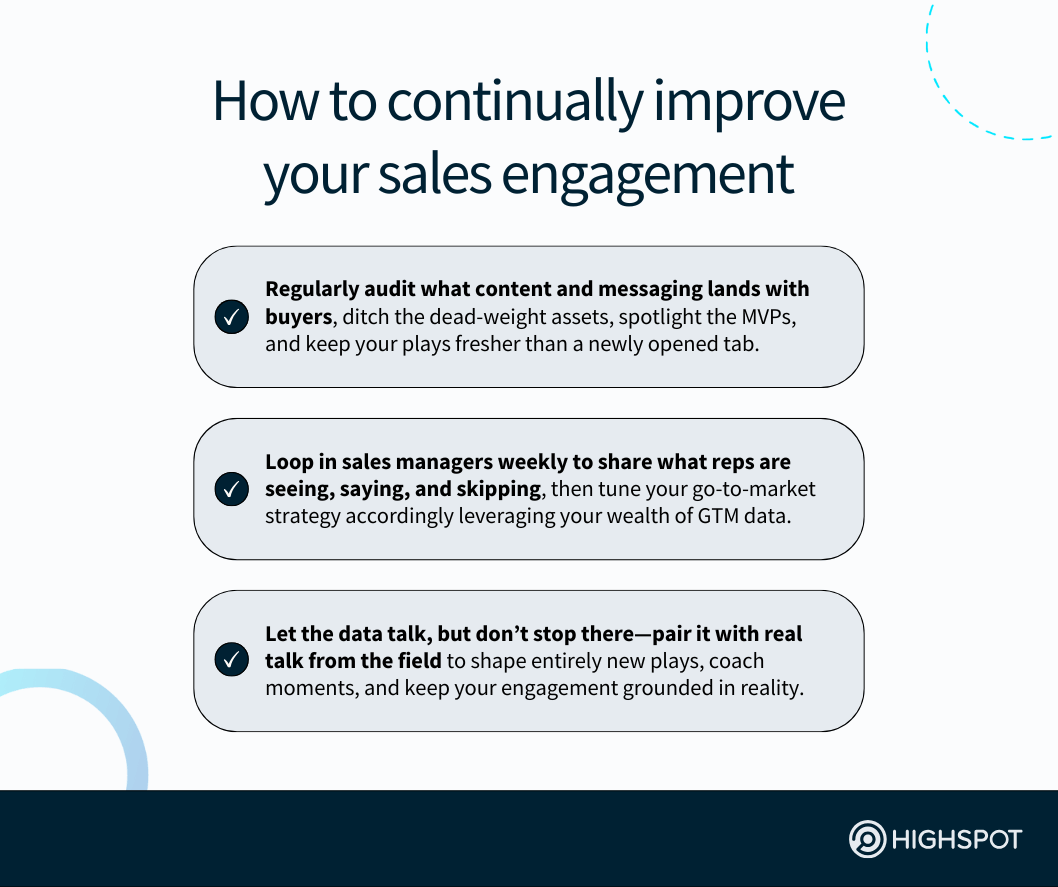Key Takeaways
- Highly effective sales engagement isn’t about BDRs doing more. It’s about doing what matters at the exact right moment, with the exact right message, for the exact right person.
- Your sales engagement strategy is part of your broader sales enablement framework, which means it should be built for scale, rooted in real-time data, and reinforced across teams.
- The way you design sales activities should make it easier for reps to connect with customers through conversations, content, and timing that actually helps them make decisions.
Your best rep is on back-to-back calls, elbow-deep in decks, and still texting a manager for the new pricing slide five minutes before entering a buyer meeting.
Their desktop is cluttered with Slack pings, CRM alerts, inbox notifications, and a half-finished pitch deck they forgot to version for the CFO on the Zoom call.
It’s not that this seller is underperforming. It’s that the way most go-to-market teams approach sales engagement makes consistency almost impossible.
Modern, effective sales engagement involves (a lot) more than sharing relevant content and nailing the right outreach sequence and cadence. It’s also about removing chaos from the selling moments that matter to empower sales team members to show up smarter to conversations with qualified leads in their pipeline.
Ultimately, your sales engagement strategy should be a real-time performance system, not a dusty playbook your sales reps try to remember to open.
When done right, it becomes the connective tissue that helps BDRs and AEs build meaningful relationships with buyers, one rep-driven moment at a time.
In the enterprise, that’s the X-factor—the edge that helps you stand out with potential customers, improve sales performance, and accelerate revenue growth.
What is sales engagement?
Sales engagement refers to the coordinated set of tactics that reps use to connect with buyers at the right times, on the right channels, and with the right content and messaging. It’s what transforms isolated seller activity into a cohesive, measurable GTM motion that drives pipeline progression and deal momentum.
- Modern sales engagement includes messaging and sharing insights with leads across multiple online touchpoints and real-world communication channels.
- This includes sending manual and automated email follow-ups featuring meeting recaps, conducting phone calls to go over leads’ pain points, and sharing digital sales rooms that act as centralized hubs for all deal-related materials.
- The goal with your sales engagement strategy is to provide a personal touch in all messages shared with prospects, share valuable insights to inform buyers’ decision-making, build strong relationships with leads so they eventually convert.
Using sales intelligence from their go-to-market enablement analytics platforms tied to real-time buyer behavior and activity data, sales reps can discover what to say to prospects and when and where to say it to maximize messaging impact.

Why continuing to optimize your sales engagement strategy is a must
For today’s B2B go-to-market teams, “sales enablement, digital-first engagement and frictionless selling are no longer optional,” Forbes Business Development Council’s Aaron Biggs recently wrote. “They’re essential for staying competitive.”
Ongoing optimization of your daily sales engagement activities as well as your broader buyer engagement approach at large is critical to smarter deal management and delivering bespoke experiences across the customer journey.
Here’s why.
Tightly aligned teams can turn the B2B buyer’s journey into a repeatable growth motion
How your salespeople engage prospects informs more than just pipeline metrics. It shapes deal velocity and buyer trust. To ensure they effectively interact with leads, though, marketing and enablement must support sellers.
When data-driven, thoughtfully crafted sales plays, content, and messaging are shared with BDRs long before calls with potential customers, giving reps time to absorb the collateral, their sales engagement becomes much more impactful.
Everyone on your sales team starts operating from the same blueprint, with clear expectations and shared accountability across touchpoints. That kind of alignment empowers sellers to more capably nurture relationships with leads, builds buyer confidence, and boost their collective sales conversion rate.
Data-backed adjustments drive more consistent execution and measurable revenue impact
Refining your sales engagement strategy with key insights that reveal what works helps sales plays land faster, hit harder, and scale without guesswork.
It’s how you elevate the quality of customer experience provided while also reducing time wasted on ineffective sales techniques or enablement content.
For instance, go-to-market teams that leverage the AI-powered insights offered in Nexus™, Highspot’s native AI and analytics engine, can more effectively tweak messaging and collateral based on actual buyer interaction data, not hunches.
Adopting this data-driven approach invariably leads to stronger sales performance by reps in the form of more affecting conversations with prospects, higher response rates with their buyer outreach, and—at the end of the day—conversion rates.
| Buying committee member | Ideal sales engagement approach |
|---|---|
| Economic buyer (CFO, COO) | Focus on ROI, time to value, and operational efficiency. Use succinct messaging, digital sales rooms with proof points, and data-backed business cases and social proof. |
| Technical buyer (CISO, IT Director) | Lead with compliance, integrations, and risk mitigation. Provide spec sheets, integration diagrams, and FAQ-driven follow-ups. |
| Functional leader (VP of Sales, CMO) | Tailor plays to their goals: marketing pipeline, rep productivity, go-to-market team efficiency. Use case studies, testimonials, and short videos that map directly to KPIs. |
| Champion (Team leads, managers) | Show how the solution makes their day-to-day work easier. Share real workflows, potential quick wins, and async training content to drive internal excitement. |
| Procurement (contract managers) | Be buttoned up about pricing clarity, terms, service level agreements, and documentation. Send personalized assets that remove back-and-forth from negotiations. |
| Executive sponsor (CEO, President) | Keep it short and strategic. Share 2–3 sharp slides that show your organization’s market relevance, business transformation potential, and impact at a high level. |
What the best sales engagement platforms offer your GTM teams today
Sales automation tools are rightfully lauded for tackling repetitive tasks like data entry and automating sales workflows of all kinds for reps and marketers today.
But don’t underestimate the power of sales engagement tools that blend conversation intelligence and pipeline analytics to help sellers better message, nurture, and convert leads and make more intelligent data-driven decisions tied to opps.
With a best-in-class sales engagement solution in platform connected with your CRM system and other core go-to-market tools, GTM teams can more effectively:
Help each sales representative build a multi-channel approach for engaging prospects
Top-performing reps don’t stick to one channel, when connecting with leads at various stages of the sales cycle. They tailor how they engage across email, phone, video, chat, and other popular touchpoints and mediums buyers prefer.
The right sales engagement platform helps your entire sales team stay visible, relevant, and accessible in a B2B buying journey that rarely follows a straight line.
Notably, it gives sales reps timely nudges to engage each buyer where they are and when they’re most likely to respond, keeping conversations moving forward and enabling sellers to act as trustworthy, readily available buyer assistants.
Provide sellers and managers automated transcripts and AI insights into calls with leads
“To drive winning behaviors, frontline managers need to understand how reps perform during sales conversations,” according to Highspot’s State of Sales Enablement Report 2025 on AI’s use in go-to-market strategies. “Yet managers don’t have the time to sit in every sales meeting or even recap what happened with sellers.”
That’s where an AI-powered conversation intelligence platform can help.
The tech captures insights, surfaces trends, and helps sales managers spot at-risk deals before it’s too late. With this clear visibility, sales leaders can coach more effectively and tailor training that improves live calls across your sales process.
Gives enablement insights into what plays, content, and messaging help close more deals
Your sales enablement leaders need a clear view into what reps are using and whether it’s helping convert. The best sales engagement platforms track outreach activities across reps, buyers, and assets, then tie it all to performance data.
Sales leaders in enablement can use these insights to help their teams refine messaging, retire content that’s stale, spotlight sales activities and messaging that consistently win, and alert reps to collateral that doesn’t move the needle.
With Highspot, Personio has transformed its sales enablement strategy. It can now leverage GTM insights to inform its sales engagement strategy so it better connects with buyers.
Offers digital sales rooms that allow BDRs to better inform and guide sellers on their journey
“The fate of every deal boils down to getting buy-in from a C-level buying committee,” per Highspot’s Power of DSRs Guide. “Sales teams need to hone their messaging and content to deliver the most strategic, impactful information from the outset so the executives holding the purse strings can make a decision—fast.”
That’s why more GTM teams are investing in digital sales room software.
Buyers can explore all assets tied to deals—product demo videos, customer success and support details, case studies, and the like—in a single centralized location.
This dynamic, digital repository elevates your sales engagement approach by giving prospects one place to engage, comment, and stay aligned.
Delivers personalized coaching and practice tools that support real-world skill growth
Using a sales engagement platform with both AI-powered sales coaching capabilities and AI role play tools can help BDRs train using real-world conversations and scenarios, helping sales managers level up reps skills using contextual data.
“Your reps can practice essential skills in a safe and scalable environment,” Highspot’s 5 Ways to Help Sellers Win with AI Role Play Guide explains. “They speak their part, AI responds like a real customer, and your reps get instant feedback that’s clear, well-rounded, and tied to the skills your team is focused on.”
That kind of precision builds seller confidence (and quickly), improves their overall sales performance, and drives up rep productivity across the board—a win-win-win for inside and field sellers, GTM leaders, and the business at large.
Surfaces next-best actions so GTM teams can move faster and prioritize what drives impact
With advanced AI and real-time analytics embedded into reps’ workflows, sales teams no longer need to second-guess what to do next or where to spend their time.
The best sales engagement platforms offer ‘smart’ recommendations tied to real GTM performance data that let teams take the right step, faster, and with less lift or overthinking.
Whether it’s assigning training, suggesting new or refreshed content, or updating a sales pitch, these nudges help reps act with intent, not just activity.
That speed and clarity provides reps (and, when looped in, AEs) insights they need to connect with buyers in the moment and keep momentum high through close.
How to better engage buyers in the sales cycle and close deals faster
A core component of GTM strategies today is building a ‘prospecting center’ for sales reps that enables them to see which communication channels (email, social media, etc.) leads prefer most and least, what messaging resonates at different buyer’s journey stages, and other key insights that can inform their outreach.
Beyond building such a sales tech stack like this, though, there are some other best practices that can help sellers engage open opps in their sales pipeline:
- Abide by the ’70-30′ lead engagement rule. When you let buyers speak 70% of the time on calls and in in-person meetings, you uncover richer context, deeper motivations, and more precise objections to work with. It’s a signal of trust and a reminder that listening well is a sales activity that drives action, not a passive exercise.
- Tailor talk tracks to a buyer’s specific role. A VP of Finance doesn’t care about the same risks or rewards as a Product Lead. So, your messaging and scripts should reflect those differences with surgical precision. Tailoring your approach to each stakeholder’s unique lens shortens the sales process and makes your message stick.
- Use async selling to create more urgency. Sending a short Loom video or annotated pitch deck after a phone call helps you stay top of mind without waiting for calendars to align. Asynchronous outreach via email, digital rooms, or voice notes keeps the momentum going while letting buyers engage on their own timeline.
- Treat lead objections as insight, not friction. Objections aren’t barriers. They’re buy signals wrapped in uncertainty, and your ability to handle lead pushback determines what happens next. When surfaced early, buyer challenges can trigger automated actions like targeted content drops, follow-up sequences, or internal coaching cues.
- Map engagement to stage-specific needs. Generic, blasé sales messaging sent at the wrong time clogs the funnel and creates drag across your entire go-to-market motion. Instead, align outreach, meetings, and collateral to the buyer’s decision phase so you can close deals with fewer follow-ups and tighter handoffs.
It’s simple: Empower your sales organization with the right tools and processes and continually refine your approach, and more closed-won business will follow.
Sales engagement insights and advice to help you improve your selling
Need more best practices to level-up your sales engagement game? We’ve got you covered.
Here are answers to common questions we hear from go-to-market leaders about how they can help their reps strengthen their sales outreach.
What should I look for when evaluating the sales engagement software for my reps?
Start with how easy a sales engagement tool makes it for reps to find what to say, send, and do, without chasing links or pinging a manager. The right platform lives where they work and gives them a clear next move. Look for coverage across email, calls, content, and follow-up that don’t force reps to jump between systems. If it’s not helping your reps win faster, it’s just getting in the way.
How can I measure the ROI of my current sales engagement programs and tools?
Link your targeted sales engagement efforts to revenue signals like speed to meeting, win rate, sales velocity, and pipeline progress. Track what content gets used by reps, what plays land with leads, and what helps advance deals from one sales cycle stage to the next. If reps are doing the work, you need proof it’s paying off. If you don’t see tangible ROI, consider upgrading your methods and/or solutions.
Can I use my sales enablement platform to engage qualified leads in my pipeline?
Yes, certain sales enablement tools, like Highspot, help reps engage buyers effectively across the entire sales process. For example, Highspot surfaces relevant content and messaging, helps sellers trigger timely outreach, automatically curates personalized digital sales rooms, and guides reps with proven plays.
What are the most common mistakes GTM teams make with sales engagement today?
Many go-to-market often over-focus on rep activity volume and neglect message quality and timing. Plays are launched but not reinforced, data ends up being siloed, and content becomes stale fast. Without coordination across enablement, sales, and marketing, engagement fails to deliver repeatable impact.
How can I use my sales analytics to improve our team’s buyer engagement efforts?
Use your sales analytics to identify which messages, plays, and content drive deal progression across roles, regions, segments, and stages. Share those insights widely to reinforce what’s working. Make data accessible to managers and reps so they can adjust in real-time and target their efforts more effectively.
Do sales engagement platforms support cross-functional go-to-market alignment?
Yes, if they connect data, tools, and workflows across go-to-market teams in one system. The right platform gives sales, marketing, and enablement shared visibility into what’s landing with buyers and where gaps exist. That alignment helps GTM teams coordinate better and execute strategic initiatives faster.
Which sales engagement metrics matter most when evaluating rep and team impact?
Prioritize sales performance metrics that reflect real pipeline movement, like reply rates, deal stage progression, and win rate by content or play. Opens and clicks of enablement content matter less without context. Focus on engagement that consistently drives revenue and helps managers improve team execution at scale.
Are there AI-powered sales engagement platforms that help reps connect with buyers?
Yes, solutions such as Highspot use AI to recommend content, suggest next steps, and surface buyer intent signals based on real-time deal data. This helps reps engage with relevance and speed, while giving GTM leaders insight into performance trends. The result is better buyer experiences and faster outcomes.




